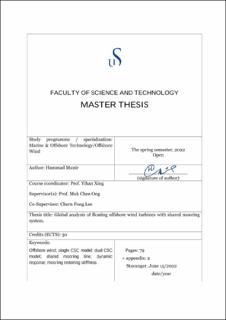| dc.description.abstract | Wind energy harvesting has increased considerably in recent decades across the world. Over the years, wind farms have gradually extended further into the sea to make use of the greater potential of wind resources in deeper water. Floating wind turbines (FWTs) might be a viable option for deep-water applications. The three most researched floating structures so far are spar, semi-submersible, and tension leg platform (TLP). Cost-effective solutions are desired for further viability and commercialization of these concepts. FWTs with a shared mooring system have the potential to be one of the most cost-efficient ways to minimize the cost of mooring. The 5-MW Conceptual Semi-Submersible Concept (CSC) floating structure with a shared mooring line is considered in the present study due to scarce research on this topic.
This study is inspired by the successful research experience of FWTs’ feasibility with a shared mooring system presented in Munir et al. (2021) which the first author is the author of this thesis. The present thesis is the continuation work which aims to further investigate the feasibility of FWTs with a shared mooring line. To achieve this, two different methodologies are adopted in Munir et al. (2021) and in the present study. In Munir et al. (2021), two single CSC FWTs are connected with a shared line by removing one anchor fixed mooring line from each. Two different configurations of FWTs are studied with 6 and 8 rotors diameter distance between the FWTs, placed horizontally. Along with the length of the shared line, static equilibrium position of FWTs is also varied. The floaters of a dual CSC model are rotated to accommodate the shared mooring line and wind turbines are rotated to experience the maximum thrust. Global analysis revealed higher maximum surge and sway offsets because of the reduced mooring restoring stiffness as compared to a single CSC model. The reduced restoring stiffness can be attributed to the reduction of one anchor fixed mooring line from each FWTs.
In the present study, three different configurations of the dual CSC model are studied with different shared line and single mooring configurations. This includes Model 1 with a medium-long shared line, Model 2 with a longer shared line, and Model 3 with a relatively shorter shared line. As an alternation of the methodology presented in Munir et al. (2021), the static equilibrium position of FWTs is kept constant at 9 rotors diameter distance and only the length of the shared line varies. The anchor positions are changed to keep the FWTs at their mean static equilibrium position in all the configurations. The orientation of the floaters and wind
turbines is same as in Munir et al. (2021). Dynamic responses of all the configurations are analyzed and compared, including the natural periods, restoring stiffness of the structures, mooring restoring force, and platform motions. The analysis revealed that the surge and sway DOFs are more influenced by the shared mooring configuration with higher offsets and natural periods as compared to a single CSC model. This happens because of the reduced mooring restoring stiffness of the structure in surge and sway directions and no shared mooring restoring force in horizontal DOFs. To avoid the snap loads and increased tension on the fairleads in extreme environmental conditions, Model 1 is recommended for further study in future as compared to Model 2 and Model 3 with a longer and shorter shared line. The results indicate that the dual CSC model with a shared line is a feasible concept and could become an alternative concept in deep water. | |
